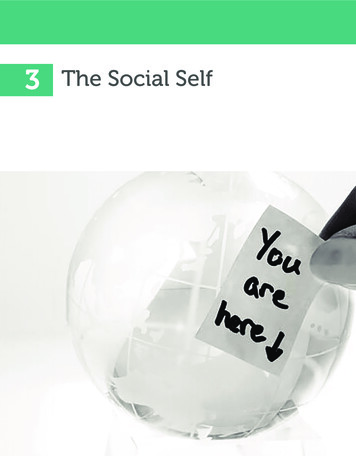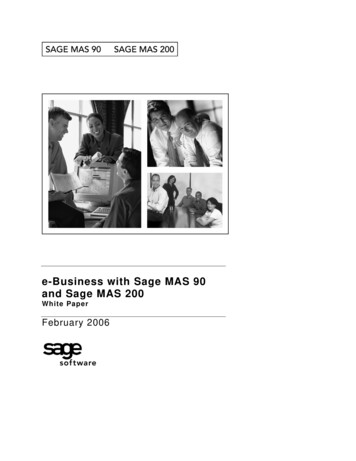
Transcription
3The Social Self
Who are you if you have lost your memory? Consider the following movies aboutmemory loss:Memento (Todd & Todd, 2000): A man finds mysterious tattoos on himself aftersustaining brain damage that prevents him from accessing any new memories.50 First Dates (Giarraputpo, Golin, Juvonen, & Producers, Segal, 2004):A woman has difficulty falling in love because she can’t remember the romanticevents from the previous day.The Bourne Ultimatum (F. Marshall, Crowley, Sangberg, & Greengrass, 2007):A CIA agent tries to figure out who he is after suffering long-term amnesia andbrainwashing.Total Recall (Moritz, Jaffe, & Wiseman, 2012): A man in the future discovershis memory has been altered and starts an adventure to discover his true self andhistory.Finding Dory (Collins & Stanton, 2016): A friendly but forgetful blue tang fishstruggles to be reunited with her long-lost parents.The characters in these memory-loss movies had to imagine their probable selvesinto existence. Hollywood scriptwriters are not the only ones using memory loss toimagine the self into existence. The rest of us also have imperfect memories, so we construct our sense of who we are by piecing together fragments of memory, interpretinguncertain evidence, and hoping for the best.The self is the story we tell ourselves about ourselves. William Swann and MichaelBuhrmester (2012) call the self a “functional fiction” because it’s a story with a purpose.And even though it’s a made-up, pieced-together tale that has an audience of only oneperson, this solitary self is also a social self. That’s because the plot of our self-storyalways involves family, friends, neighborhood, culture, and much more. To understandhow each of us live, think, and behave in a social world, we have to first understand howwe define and perceive ourselves.By the end of this chapter, you will be able to answer the following questions:Core QuestionsLearning Objectives1.What is the “self?”1.2.How do we know the self is social?Explain how social psychology has definedself-awareness and the self-concept.3.Why do we present different selves indifferent situations?2.Analyze how our self-perceptions are influencedby others.4.Is the truth always the self’s friend?3.5.What is self-esteem and how can wemeasure it?Explain how we adjust our public self-presentationto influence others.4.Articulate why we sometimes benefit from positiveillusions and moderate self-deceptions.5.Apply both explicit and implicit methods to themany facets of self-esteem, including its dark side.CHAPTER 3 The Social Self3
WHAT IS THE “SELF?”Learning Objective 1: Explain how social psychology has definedself-awareness and the self-concept.Perhaps the proverbial slap on a newborn baby’s backside (or the more likely suctiondevice up the baby’s nose) first jars us into self-awareness. Before that moment, we werepart of someone else’s body. With a snip of the umbilical cord and a sudden breath ofair, we became a separate, living creature. But did we know it at that moment? The scientific challenge is to develop a reliable way of discovering how and when we developself-awareness (also called self-recognition), the understanding that we are a separateentity from other people and objects in our world. The experience of becoming selfaware (Sedikides & Skowronski, 1997) is not easy to document with the reliability andvalidity that science requires.The Scientific Study of Self-AwarenessHow we think about ourselves changes over the entire arc of our lives. The creator ofpsychology’s first textbook, William James (1890), wrote that the self “is the sum total ofall that a person can call his [today we would add “or her”] own,” includingnot only his body and his psychic powers, but his clothes and his house . . . hisreputation and works . . . his yacht and his bank-account. All these things givehim the same emotions. If they wax and prosper, he feels triumphant; if theydwindle and die away, he feels cast down. (p. 292)How has science approached the abstract and changing construct of self-awareness?Early Research on Self-Awareness: Darwin and Imitation. He was really just a proudpapa. Charles Darwin couldn’t help but notice interesting things about the developmentof his beautiful new baby. The scientific study of self-awareness began with Darwin’snaturalistic observations of William, the first of the 10 children of Charles and EmmaDarwin. Darwin (1877) carefully observed and reported that his infant son began imitating what he saw and heard:When our infant was only four months oldI thought that he tried to imitate sounds; butI may have deceived myself, for I was notthoroughly convinced that he did so until hewas ten months old. (p. 286)Infants mirror the expressionsof adults while becoming awareof themselves as independentbeings.4SOCIAL PSYCHOLOGYSince these first observations from Darwin, scientists have been studying imitation as an early signof self-awareness (Anderson, 1984; Damon & Hart,1988). A 1977 study documented 2- to 3-week-oldinfants imitating a mouth opening, a finger moving,or a tongue appearing between the lips (Meltzoff &Moore, 1977). By 1989, the same research team haddocumented imitation among infants who were lessthan 72 hours old (including a 42-minute-old infant!). Four-month-old infants reliablydisplay a more distinct sense of self by smiling more and looking longer at pictures ofothers compared to looking at pictures of themselves (Rochat & Striano, 2002).
Testing Self-Awareness: The Mirror Self-Recognition Test. Imitationis interesting to see in infants, but does it really mean that they haveself-awareness? To more directly test this, scientists—including Darwin—wanted to come up with a way to test whether people (and animals) seem torealize they are independent, unique entities. Do all animals have a sense ofself, or is this perception unique to humans?Darwin (1872) tried to answer that question with an experiment. Hereported thatmany years ago, in the Zoological Gardens, I placed a lookingglass on the floor between two young [orangutans]. . . . Theyapproached close and protruded their lips towards the image, as ifto kiss it, in exactly the same manner as they had previously donetowards each other. (p. 142)Those orangutans acted as if the creature in the mirror were anotheranimal, not themselves, suggesting that they did not possess self-awareness.Almost 100 years later, in 1968, Gordon Gallup followed Darwin’s leadby attempting to find out whether some animals respond to their mirrorimage “as if their image represented another animal” (Gallup, 1968, p. 782).So he created a more controlled version of Darwin’s original experiment by first anesthetizing some chimpanzees, macaques, and rhesus monkeys. While they were unconscious,Gallup marked each animal with a nonodorous, nonirritating red dye just above the eyebrow. The animals could not smell, feel, or see the red dye without the help of a mirror.What would it mean if an animal looked into the mirror, saw the unmistakable reddye, but did not touch the red dye? The animal probably perceived that the creaturein the mirror was just some other animal that happened to have a red splotch on itsforehead. But what if an animal looked into the mirror and touched the unusual reddye on its own face—not on the mirror? In that case, the animal was telling us, “That’sme in the mirror: I am—and I know that I am the one with the red mark.” The mirrorself-recognition test (also called the mark test) creates an opportunity for animals todemonstrate self-awareness. In Gallup’s first study, the four chimpanzees (but not theother primates) did indeed touch the red mark on their foreheads. Voila! Gallup hadscientifically demonstrated self-awareness among chimpanzees.Do non-human animals have a sense of self? A YouTube.com search for “animal self-recognition” results invideos on elephants, lions, chimpanzees and otherstoying with their image in a mirror.Charles Darwin noted earlysigns of mental developmentin his infant son, William. His“eyes were fixed on a candleas early as the 9th day . . . onthe 49th day his attention wasattracted by a bright-colouredtassel” (Biographical Sketch ofan Infant, p. 286)Dogs seem to be aware when they have misbehaved. Theyappear to demonstrate something like shame - but only whenthey are caught.CHAPTER 3 The Social Self5
More recently, mirror self-recognition studies have also documented self-awarenessamong Asian elephants (Plotnik, de Waal, & Reiss, 2006), killer whales (Delfour &Marten, 2001), and dolphins (Marino, 2002). Self-awareness among animals is no surprise to dog owners. Misbehaving dogs will slink about and put their tails between theirlegs in ways that suggest awareness of a guilty self.Defining and Measuring the Self-ConceptThe self-concept is the personal summary of who we believe we are; it is how we answerthe question, “Who am I?” It includes our assessment of our positive and negativequalities, our relationships to others, our beliefs and opinions, and more. We acquire aself-concept in several ways, including the following: We compare our self to others (social comparison theory). Culture creates expectations about how the self should behave (social identitytheory). We create mental structures that direct the self ’s attention (self-schematheory).Let’s consider each of these theories in more detail.Social Comparison Theory. Social comparison theory proposes that we usesocial comparisons to construct our self-concept, especially when we have no otherobjective standard available to us (Festinger, 1954). How do you know if you are shy,competitive, rich, anxious, or anything else? These subjective ideas only become meaningful in comparison to others.For example, if you are walking alone on the beach, you may not even be thinkingabout your physical appearance. But when someone much more attractive walks by, theunflattering social comparison can deliver a small shock to your previously contentedself-concept (Bachman & O’Malley, 1986; Marsh, Köller, & Baumert, 2001). At a basiclevel, there are two types of social comparisons we can make. Upward Social Comparisons. When we make an upward social comparison,we compare ourselves to someone who is better than us. This type ofcomparison can be useful when we want to improve on a particular skill. Mostpeople who like to watch cooking shows with celebrity chefs enjoy gettingtips on how to make their own food taste or look better. The same is truefor people who get ideas about home decorating from Martha Stewart or byreading magazines with ideas, or when athletes learn from coaches. However,constantly comparing ourselves to people who have excelled can lead tofrustration or even depression—why can’t my cupcakes look as good as theones on Pinterest? Downward Social Comparisons. That’s where the second type of socialcomparison comes into play: downward social comparison. This occurswhen we compare ourselves to someone who is worse than we are. This mightnot help us improve, but it sure feels better. My cupcakes might not winany cupcake reality show contests, sure, but it’s better than the cupcake mydaughter tried to make, for example. My tennis skills aren’t on a professionallevel, maybe, but I’m better than the guy in the next court who can’t hit asingle ball over the net.6SOCIAL PSYCHOLOGY
How we process those social comparisons also makes a difference (Suls & Wheeler,2000). The W.I.D.E. guide to social comparisons identifies four factors relevant to oursubjective processing of what we see around us (see Figure 3.1): Who. We evaluate our abilities automatically (Gilbert, Giesler, & Morris,1995) by comparing ourselves to similar others (Gibbons & Buunk, 1999).Tennis players who are about my ability level or a little better give me the mostuseful social comparison feedback. Interpretation. How we interpret social comparisons influences our selfconcept. Moving into a group home with sick elderly neighbors could beprocessed in two very different ways (Michinov, 2007): (1) “Thank goodnessthat I’m not that ill,” or (2) “Very soon, I also could be just as needy”(Brandstätter, 2000). Direction. The direction of our social comparison influences our selfconcept. Comparing myself to better tennis players is an upward socialcomparison (that makes me feel worse) and comparing to worse playersis a downward social comparison (that makes me feel better). Downwardsocial comparisons tend to enhance our self-concept (Burleson, Leach, &Harrington, 2005; Gibbons et al., 2002; Guimond et al., 2007; Major,Sciacchitano, & Crocker, 1993). Esteem. Protecting our self-esteem influences our self-concept. The losingtennis player may say to her opponent, “You played extremely well today,”implying that her opponent had to play his or her best to beat her (Alicke,LoSchiavo, Zerbst, & Zhang, 1997). We’ll talk more about self-esteem—and how we use psychological tricks to protect it—a little later in thischapter.Social Identity Theory. Henri Tajfel was in a bad situation when he was capturedby German soldiers during World War II. He was a Polish-born Jew who had volunteered to join the French army. When the Germans asked who he was, he faced a terribledilemma; should he admit he was Jewish? He did—but he also falsely presented himselfas a French citizen, which probably saved his life. After surviving the war with otherFrench prisoners, Tajfel became a social psychologist who proposed that the self is composed of two general categories:(1) personal characteristics (serious, funny, grumpy, tall, or rich), and(2) social role characteristics (son, mother, musician, Catholic, or accountant).FIGURE 3.1 T he W.I.D.E. guide suggests that social comparisonsIn other words, there are at least these twoare made up of four factors.sides to the self, and they each have many working parts. You are not just “funny”; you are manyWIDEother things: short-tempered, generous, and soforth. You are not just a student; you are also aWhoInterpretationDirectionEsteemdaughter or son who has a certain ethnic heritage, religious upbringing, and sexual orientation. Your complicated self is organized around what Tajfel called social identitytheory, which proposes that our self-concept is composed of a personal identity anda social identity (see Rivenburgh, 2000; Sherif, 1966b; Tajfel, 1981, 1982; Tajfel &Turner, 1986). What are some examples of social identities?CHAPTER 3 The Social Self7
The social self is influencedby cultural expectations andtraditions that show up insurprising ways in controlledexperiments.The Regional Self. One social identity is based on where you are from. Thewell-known social psychologist Roy Baumeister (1986) pointed out that in Medievaltimes, a person’s region was sometimes part of his or her name; “Leonardo da Vinci”means “Leonardo, from Vinci.” Regional identity is also apparent in many of theWorld War II cemeteries in France for soldiers from different countries who diedduring the Normandy invasion. The cemetery designers organized the soldiers indeath—as in life—in regional groups organized first by country and then by regionwithin that country.Regional affiliations influence how others perceive us and how we, in turn, perceiveourselves. For example, one research team found that within the United States, peoplefrom Massachusetts are often perceived as intelligent but snobbish, Iowans as hardworking but hicks, Georgians as hospitable but racist, and New Yorkers as ambitious butrude (Berry, Jones, & Kuczaj, 2000). Do you feel proud when someone from your country, especially from your region of the country, wins at the Olympics? You probably didn’ttrain, sacrifice, donate money, or even care very much who won until you turned on thetelevision. Nevertheless, our national and regional identity influence our self-concept.The Cultural Self. The tricky thing about our cultural self is that we are mostlyunaware of it until we happen to bump into another culture. Cultural collisions createhumorous situations that have produced some great comedic films such as My CousinVinny (Launer, Schiff, & Lynn, 1992), Bend It Like Beckham (Chadha, Nayare, &Chadha, 2002), My Big Fat Greek Wedding (Goetzman, Hanks, Wilson, & Jones, 2002,2016), and even Elf (Berg, Komarnicki, Robertson, & Favreau, 2003). If you have evertraveled to another country, your assumptions, way of life, clothing, and more may havesuddenly become salient to you in new ways because you may suddenly realize that yourview of the world is changed due to your cultural self.Independent and Interdependent SelfConstruals. By placing Western and Asian culturesSocial Identityon a cultural continuum, Figure 3.2 adds an additional(Asian)layer to Tajfel’s social identity theory. This continuumis anchored by a personal, independent self-construalRelatednessCollectivism(many “Western” cultures) at one end and a social,Interdependenceinterdependent self-construal (many Asian cultures) atSelf-Effacementthe other end.This means that the ideal self in one culture is verydifferent from the ideal self in another culture. The rugged individualist so valued inthe United States will likely be perceived as rude and insensitive in Japan. The conciliatory team player so valued in Japan may be perceived as wimpy and nonassertive inthe United States. Table 3.1 helps us understand how cultural norms influence how wethink about the self (Markus & Kitayama, 1991).FIGURE 3.2 Identity can be shaped by culture.Personal Assertiveness8SOCIAL PSYCHOLOGY
TABLE 3.1 Some Examples of How Culture Affects Views of the SelfTo guide groupbehaviorTo get children tofinish their foodTo improve workerproductivityAmericanculturerecommendsthat . . . . . the squeakywheel gets thegrease. . . children think ofthe starving childrenin Ethiopia and howlucky they are to beAmerican. . . workers standin front of a mirrorand repeat: “I ambeautiful.”Japaneseculturerecommendsthat . . . . . the nail thatstands up getspounded down. . . children thinkabout the farmerwho worked so hardto produce the ricefor you and howdisappointed he or shewill be if it is not eaten. . . workers hold acoworker’s hand andrepeat: “He or she isbeautiful.”Self-Schema Theory. A third way to think about how the self-concept is formedis through self-schemas, memory structures that summarize and organize our beliefsabout self-relevant information (Markus, 1977). A schema in general is a cognitive andmemory structure for organizing the world, so self-schemas transform the raw materialfrom cultural social comparisons into the building blocks of our self-concept (Hewitt& Genest, 1990), creating what Cervone (2004) calls “the architecture of personality.”For example, let’s say that you wake up late on Wednesday morning. Is your lateness because you are lazy or because you work so hard that you’re exhausted? You thenspeed in traffic heading to your job. Is your speeding because you are a dangerous, careless driver or because you are responsibly trying to get to work as quickly as possible?When you get to work, the first thing you do is get some coffee from the breakroom.Are you addicted and trying to procrastinate, or are you simply trying to get focused soyou can be efficient? Instead of chatting with coworkers, you head straight to your desk.Are you rude or simply motivated to accomplish that day’s tasks?Your self-concept creates a coherent self by activating particular self-schemas thathelp you interpret your own behavior. In this example, your efforts to get to work couldlead you to think of yourself in two very different ways: (1) you are lazy, dangerous,addicted, and rude, or (2) you are hard-working, responsible, highly motivated, anddetermined to succeed. How you interpret the flow of everyday events in your lifedepends on which self-schemas have been activated, as the schemas create cognitiveframeworks for you to interpret the events of your life.The Main Ideas1. Self-awareness is the understanding that we are a separate entity from otherpeople and objects in our world. One way that scientists have attempted tomeasure self-awareness is called the mirror self-recognition test.2. Our self-concept is the personal summary of who we believe we are.3. Social comparison theory proposes that our sense of self is influenced by differenttypes of social comparisons, including upward (comparing the self to someonewho’s better) and downward (comparing the self to someone who’s worse).4. Social identity theory describes the self as a mixture of personal and socialidentities, and self-schema theory suggests that we organize our beliefs aboutourselves into mental structures in memory.CHAPTER 3 The Social Self9
CRITICAL THINKING CHALLENGE Identify three activities you enjoy doing, such as sports, hobbies, and studyingvarious subjects. Then, make one upward social comparison and onedownward social comparison for each activity. As you identified one personwho was better than you and one person who wasn’t as advanced, whatemotions resulted from each type of comparison? List three ways that you typically perceive the world that you think might havebeen influenced by your regional, national, or specific social cultures. Oneway to do this might be to think about how your perceptions might be differentfrom the perceptions of people from different cultures. Analyze the pros and cons of having a false but positive self-concept. Forexample, you might delude yourself about how you are now, but would thisdelusion eventually shape you into a better person?HOW DO WEKNOW THE SELF IS SOCIAL?Learning Objective 2: Analyze how our self-perceptionsare influenced by others.Magnificent? Yes, humans are in many ways. But we are alsopetty, deceitful, prone to violence, moody, and many otherunattractive things. Like winning the lottery, the gift ofself-awareness changes our lives in both good and bad ways. Wecan’t un-win the lottery once we have won it, and we can’t undohaving self-awareness and a self-concept once they have evolved.But how do we know that the self is social? You can think of thesocial self as the storytelling ringmaster in the three-ring circusof our complicated lives. It directs the spotlight of our attentionand narrates a story that brings coherence to our otherwise chaotic interactions with others.Here are three strands of evidence indicating that theself is social: (1) our self-perceptions rely on the behaviors wedisplay to others, (2) self-discrepancy theory describes howdifferent components of the self are influenced by others, and(3) our sense of self often includes other people. Let’s talkabout each strand.Self-Perception Theory:Behaviors Tell Us Who We AreOur “self” sometimes seems likea circus ring master. It usuallydirects our attention to the mostpositive self-performances.10SOCIAL PSYCHOLOGYA friend of mine [Wind’s] met my parents a few years ago andwas chatting politely with them. My friend casually mentionedto my parents, “Wind really loves waffles!” I was surprised—I don’t think I had ever talked to my friend about waffles, andI didn’t really consider myself a big waffle fan. When I asked myfriend about her statement, though, she said, “Every time we go to brunch, you alwaysorder waffles.” I thought about it for a second, realized she was right, and realized thatyes, I guess I do love waffles! This experience demonstrates self-perception theory.
Self-perception theory proposes that we get help answering the question, “Who amI?” by making inferences about ourselves based on observing our own behaviors (Bem,1967; Bem & McConnell, 1970). To understand this theory, first think about howyou form perceptions of other people. You watch their behaviors and infer—or guess,really—about their motivations, attitudes, values, and core traits based on the behaviorsthey display to you. You never really know what’s going on behind the metaphoricalcurtain of these outward behaviors.Self-perception theory proposes that we form our self-concept in very similar ways.Perhaps we don’t really have special, privileged access to our inner thoughts and choicesall the time—and we thus try to infer our own motivations, attitudes, values, and coretraits based on observing our own behaviors. If you regularly volunteer at a local dogshelter, then you must be someone who cares about animals. If you love to travel and eatexotic foods, then you must be open to new experiences. We define our self, in part, byhow we observe ourselves as we interact with others.In this way, self-perception theory is the idea that our self-concept forms by observing our own behaviors in a social world. If other people seem to think we’re funny, wewill likely incorporate “good sense of humor” into our self-concept. If other peoplelook to us to make decisions about where to eat every Friday night, we might come tobelieve we’re decisive leaders. And if you always order waffles when you go to brunchwith friends, you probably love waffles. Again, because the self-concept is abstract andsubjective, one of the most straightforward ways to decide who we are is by simplyobserving what we do.Self-Discrepancy Theory:Are We Trying to Juggle Three Selves?So far, we’ve been talking about the self as if we all have a fully formed and singleself-concept. Psychologist Tory Higgins (1987, 2002) suggested that in reality, we allhave three simultaneous selves. We juggle these selves all at once, and they frequentlychange shape while in the air. As you learn about each one, consider how each contributes to your own self-concept.The Actual Self. Our first self is our “actual self,” which is simply who we think weare, right now. It includes both our good and bad qualities, as well as the qualities wethink other people see in us. The actual self is who we are currently, as if someone tooka snapshot of our evolving lives. A meaningful actual self can acknowledge our strengthsand admit our weaknesses.The Ideal Self. Higgins hypothesizes that we also have an “ideal self,” which is theperson we would like to become in the future. It includes enhancing or adding positivequalities that we don’t think are maximized in the actual self, and it means eliminatingor at least reducing negative qualities we have right now. Our ideal self is our dreamsand goals, the person we strive to become. Importantly, our ideal self is truly based onwhat we want, even if that means secret desires we’ve never been able to admit to anyoneelse. If you could, for example, have any job in the world, or look a certain way, or live aparticular lifestyle, what would it be?The Ought Self. In contrast with the ideal self, our “ought” self is what we thinkother people expect of us. The ought self is based on our perception of what our socialworld hopes for us, perhaps what our parents want us to do or be, what our friendsbelieve would be good for us, or even what our culture tells us is proper and correct. TheCHAPTER 3 The Social Self11
ought self may influence how we dress, for example, because we know what is expectedof us. Interestingly, our ought self might change based on whom our reference is. Forexample, what you think your parents expect of you might be very different from whatyou think a first date expects of you.When Selves Don’t Align: Self-Discrepancy. Higgins suggests that not onlydo we have to juggle these three simultaneous selves, but we also have to deal with timeswhen the selves don’t match up. He refers to the mismatch between our three selves asself-discrepancy. How do you feel when your actual self doesn’t match your ideal self?Are these emotions different from those you experience when your actual self doesn’tmatch your ought self?Our discrepancies have predictable consequences that Higgins explored in research.He found that when the actual self and ideal self don’t match—in other words, whenwe don’t live up to our own ideals or we fail to achieve our dreams—we will experience “dejection-related emotions” such as disappointment, shame, embarrassment, andpossibly even depression (Higgins, 1987).On the other hand, sometimes our actual self doesn’t match our ought self. Whenthis happens, we’ll feel that we haven’t lived up to others’ expectations—and that kindof failure produces “agitation-related emotions” such as guilt, fear, self-contempt, andanxiety. Of course, the ideal situation would be that all three selves (actual, ideal, andought) are exactly in alignment, with perfect overlap. As you can see in Figure 3.3, thiswould be like a Venn diagram of three circles. Each time the selves get closer together,the circles overlap more until only a single, perfect circle remains because they are all thesame self. How likely do you think this is to achieve? Can you see discrepancies betweenyour actual, ideal, and ought selves?For more on self-discrepancy theory, see the Social Psychology in Popular Culturefeature on “Self-Discrepancy Theory and Wonder Woman.”Self-Expansion Theory:Inclusion of Others in the SelfWhile self-discrepancy theory suggested that we might have more than one self-concept,other social psychologists have suggested that our self-concept might even include otherpeople. Certainly, social identity theory noted that our sense ofFIGURE 3.3 T hree selves might exist for each of us,self includes our group memberships and our relationships withaccording to self-discrepancy theory.other people. But could our abstract sense of self also actuallyinclude specific other individuals in our social world?Self-expansion theory is the idea that all of us have abasic motivation to grow, improve, and enhance our selfIdeal SelfOught Selfconcept; we all want to reach our greatest potential (Aron, Aron,& Norman, 2001; Aron & Aron, 1996). While other theorieshave noted that we can do that through things like identifyingour flaws or working toward our ideal self, self-expansion theory specifically suggests that one common way we attempt to“expand” our self-conc
Explain how social psychology has defined self-awareness and the self-concept. 2. Analyze how our self-perceptions are influenced by others. 3. Explain how we adjust our public self-presentation to influence others. 4. Articulate why we sometimes benefit











